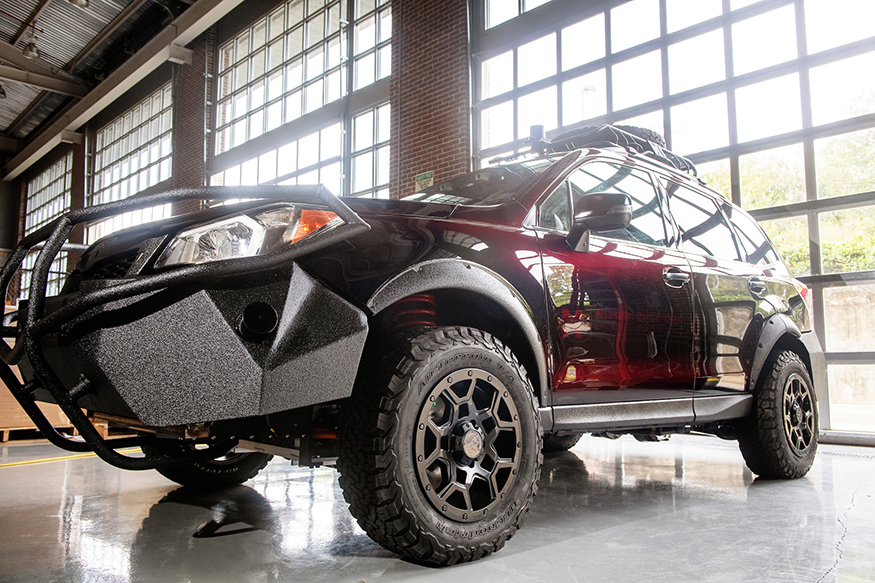MSU debuts ‘Halo Project’ supercar in Las Vegas

Contact: James Carskadon
STARKVILLE, Miss.— Mississippi State researchers and students are traveling 1,757 miles this week to unveil the university’s “Halo Project” supercar at the world’s premier automotive specialty products trade event.
The SUV, an all-electric sport utility vehicle that is pushing the boundaries of autonomous vehicle capabilities, makes its debut Oct. 30-Nov.2 at the 2018 SEMA (Specialty Equipment Market Association) show.
Designed to function autonomously in off-road environments by an MSU team at the university’s Center for Advanced Vehicular Systems, the vehicle is built with the latest automotive technology and is paving the way for advancements in a key area with personal, military, agriculture, and search and rescue implications.
CAVS is attending SEMA as a guest of the Society of Collision Repair Specialists. The car will be in booth 1173 at SEMA.
“The Halo Project itself serves as a platform for our researchers to demonstrate their expertise, on a real-world, high-performance vehicle,” said Matthew Doude, CAVS associate director and Halo Project lead. “Less than one percent of the Earth is paved, so we needed a vehicle that could be a capable development and test platform both on- and off-road. The Halo Project vehicle is all-wheel drive with tons of wheel torque from its four independent electric motors. This allows us to do research on topics like self-driving cars, even in rugged environments.”
The supercar, a modified Subaru Forrester, utilizes an on-board NVIDIA supercomputer that allows the vehicle to navigate on and off-road terrain without human intervention. MSU recently acquired property that CAVS will use to house an autonomous vehicle test track. CAVS also is developing the MSU Autonomous Vehicle Simulation platform.
“The students and researchers have been working so hard to make this project possible,” said CAVS Executive Director Clay Walden. “I think this car makes an impactful statement about our contribution to the future of autonomy and off-road mobility.”
The project builds on a series of MSU automotive research projects, including the “Car of the Future,” an all-electric vehicle that combines superior efficiency, sporty handling and advanced technological features. MSU student, faculty and staff research teams have long been recognized for excellence in projects like “Car of the Future,” national competitions such as EcoCAR, and other initiatives that have pushed innovation.
The Halo Project supercar shows the strength and depth of MSU’s research partnerships, Doude said. In addition to students and research faculty, the Halo project team comprises domestic and foreign companies that have successfully partnered with MSU on previous projects and serve a global customer base.
Features of the car include:
—Navigation of a wide variety of terrain autonomously by using a sensor packing that includes LiDAR, radar and cameras. Four LiDAR sensors will create detailed 3D maps of the vehicle’s surroundings, while stereo cameras will serve as the car’s eyes and help it recognize and classify objects. Radar will allow the vehicle to see better through rain and snow, as well as identify types of terrain in front of the vehicle. All of the sensor data will be fed into an onboard supercomputer, provided by NVIDIA.
—Next-generation lithium ion battery produced by Michigan-based A123, an international leader in battery technology, enabling the vehicle to travel an estimated 230 miles on a single charge. The battery has more than 50 percent more energy capacity than the previous generation.
—Four electric motors powering each wheel individually and providing over 10,000 newton meters of torque. Built by YASA, the motors are coupled with high-power inverters made by Rinehart Motion Systems.
—Torque to the wheels through custom-designed transmissions provided by Hewland Engineering of Berkshire, United Kingdom.
—Custom body work and paint by Clinton Body Shop to ensure that the vehicle looks the part of a supercar. The shop also provided the paint for MSU’s internationally-recognized “Car of the Future” vehicle.
—A suspension that was partially built using steel that was melted, cast and rolled at the CAVS steel research center.
Work on the Halo Project has been ongoing for more than a year. The car will be displayed at various conferences and automotive events. In addition to highlighting MSU’s advanced engineering capabilities, the car will immerse undergraduate and graduate students in advanced automotive technology and research.
CAVS is an interdisciplinary center comprised of research, engineering design and development, as well as technology transfer teams for industry and government partners. For more, visit www.cavs.msstate.edu.
MSU is among the nation’s leading research universities and is available online at www.msstate.edu.